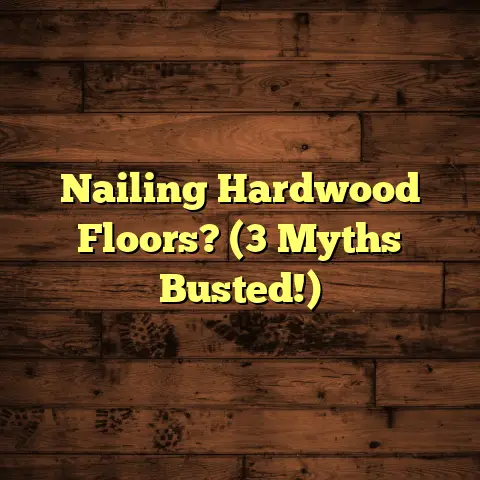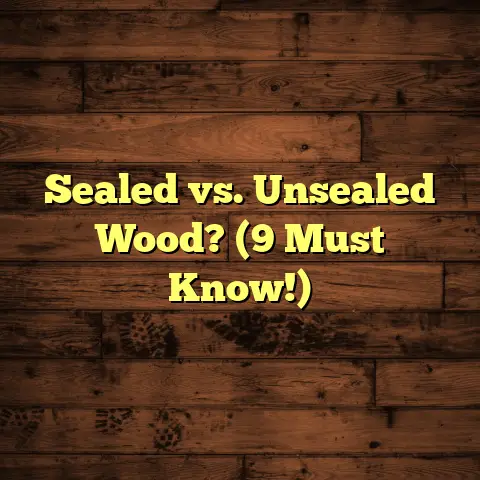Repairing Floor Boards: Is It DIY? (8 Fix Steps!)
With more of us working from home these days, a quiet environment is more important than ever. So, can you tackle those noisy floorboards yourself? Absolutely! Let’s dive into the world of floorboard repair and see if it’s a DIY-able project for you.
Section 1: Understanding Noise Reduction in Flooring
1. The Science of Sound Transmission
Ever wonder why some rooms are echoey and others are quiet? It’s all about sound transmission. Sound travels as vibrations, and different materials transmit those vibrations in different ways. Hard surfaces like tile or concrete reflect sound, while softer surfaces like carpet absorb it.
Think of your floor like a drum. A tightly stretched drumhead (a well-installed floor) produces a clear, resonant sound. A loose or damaged drumhead (squeaky floorboards) produces a dull, rattling sound.
The density and composition of your flooring material play a huge role. Hardwoods tend to transmit sound more readily than softer woods or materials like cork.
2. Types of Noise
Floorboards contribute to a few different types of noise:
-
Impact Noise: This is the “thud” of footsteps, dropped objects, or furniture being moved. It travels directly through the floor and can be heard in the rooms below.
-
Airborne Noise: This includes voices, music, and TV sounds. While not directly caused by the floor, a poorly insulated floor can allow airborne noise to travel more easily between rooms.
According to the National Research Council Canada, impact noise is a major source of annoyance in multi-family dwellings. Reducing impact noise from flooring can significantly improve the quality of life for residents.
3. The Role of Floorboards
So, how do your floorboards specifically contribute to the problem? Squeaks are the most common culprit. They happen when boards rub against each other, the subfloor, or nails/screws. This friction creates that high-pitched, irritating sound.
Loose boards are another issue. When a board isn’t properly secured, it can vibrate and amplify sound.
Even small gaps between boards can act like tiny sound tunnels, allowing noise to travel more easily.
Section 2: Evaluating Floorboard Damage
1. Identifying Problem Areas
Time to put on your detective hat! Walk around your house and listen carefully. Where are the squeaks coming from? Have someone else walk while you listen from below (if you have access to a basement or crawlspace).
Visually inspect your floors. Look for:
- Gaps between boards
- Loose or lifted boards
- Cracks or splits
- Signs of water damage (stains, warping)
Pro Tip: Mark the squeaky spots with painter’s tape. This will help you remember where to focus your efforts.
2. Assessing Damage Severity
Is it just a minor squeak, or is the floorboard cracked in half? This will determine the type of repair needed.
-
Minor Squeaks: Usually caused by friction between boards or loose fasteners. These are generally easy to fix.
-
Cracks and Gaps: Can be filled with wood filler or caulk. Larger cracks might require board replacement.
-
Warping: Often caused by moisture. If the warping is severe, you’ll likely need to replace the board.
-
Loose Boards: Need to be re-secured to the subfloor.
If you’re unsure about the severity of the damage, it’s always a good idea to consult with a flooring professional.
Section 3: Tools and Materials Needed for Repair
Okay, let’s gather our gear! Here’s a list of essential tools and materials:
1. Essential Tools
- Pry Bar: For gently lifting boards (use with caution!).
- Hammer: For tapping boards into place and driving nails.
- Screws: Specifically designed for wood flooring.
- Wood Glue: For bonding wood surfaces.
- Drill: With various drill bits for pilot holes and driving screws.
- Wood Chisel: For removing small pieces of wood.
- Circular Saw or Hand Saw: For cutting replacement boards.
- Safety Glasses: Protect your eyes!
- Hearing Protection: Especially when using power tools.
- Dust Mask: To avoid breathing in sawdust.
2. Material Selection
Choosing the right materials is crucial for a successful repair.
- Hardwood: If you have hardwood floors, you’ll need to match the species (oak, maple, etc.) and the finish.
- Laminate: Purchase a replacement board from the same manufacturer and style, if possible.
- Engineered Wood: Similar to laminate, try to match the original product.
- Wood Filler: Choose a color that closely matches your floor.
- Shims: Thin pieces of wood used to fill gaps and stabilize boards.
Matching the wood type and finish is essential for a seamless repair. I’ve seen too many DIY projects where the mismatched wood sticks out like a sore thumb!
Section 4: Step-by-Step Repair Guide
Alright, let’s get to work! Remember to prioritize safety and take your time.
1. Step 1: Preparation and Safety
- Clear the Area: Remove furniture and rugs from the work area.
- Protect Yourself: Wear safety glasses, hearing protection, and a dust mask.
- Ventilation: Open windows or use a fan to ventilate the area.
- Inspect for Hazards: Check for electrical wires or plumbing before you start cutting or drilling.
2. Step 2: Locating and Fixing Squeaks
- Identify the Squeak: Have someone walk over the area while you listen closely.
- Shim It: If the squeak is caused by a gap between the floorboard and subfloor, insert a thin shim coated with wood glue.
- Screw It: Drive screws through the floorboard into the joist below. Use pilot holes to prevent splitting the wood. Angle the screws slightly for better grip.
I often use a “squeak-squasher” screw kit, which includes specialized screws designed to eliminate squeaks.
3. Step 3: Repairing Cracks and Gaps
- Clean the Area: Remove any debris from the crack or gap.
- Apply Wood Filler: Use a putty knife to press wood filler into the crack. Overfill slightly.
- Let it Dry: Allow the wood filler to dry completely according to the manufacturer’s instructions.
- Sand it Smooth: Use fine-grit sandpaper to sand the filled area flush with the surrounding floor.
- Stain and Seal: Apply stain and sealant to match the existing floor finish.
For larger gaps, you might need to use wood caulk, which is more flexible than wood filler.
4. Step 4: Replacing Damaged Boards
This is the most challenging repair, but definitely doable with patience.
- Score the Board: Use a utility knife to score the perimeter of the damaged board. This will prevent splintering when you remove it.
- Remove the Board: Use a pry bar to gently lift the board. Be careful not to damage the surrounding boards.
- Cut the Replacement Board: Measure the space and cut a replacement board to the exact size.
- Install the New Board: Apply wood glue to the edges of the replacement board and carefully fit it into place.
- Secure the Board: Use nails or screws to secure the new board to the subfloor.
- Finishing Touches: Sand, stain, and seal the new board to match the surrounding floor.
Pro Tip: When cutting the replacement board, make sure to cut it slightly longer than the space. You can then use a wood chisel to fine-tune the fit.
5. Step 5: Reinforcing Loose Boards
- Locate the Loose Area: Identify where the board is moving or flexing.
- Add Support: If the board is loose due to a gap between the subfloor and joist, insert shims coated with wood glue.
- Screw It Down: Drive screws through the board into the joist below. Use pilot holes to prevent splitting.
Sometimes, the subfloor itself is the problem. In that case, you might need to reinforce the subfloor with additional plywood.
6. Step 6: Soundproofing Techniques
While you’re repairing the floor, consider adding some soundproofing measures.
- Underlayment: Install a sound-dampening underlayment beneath the floorboards. This can significantly reduce impact noise.
- Acoustic Caulk: Seal any gaps around the perimeter of the room with acoustic caulk. This will help to block airborne noise.
- Mass-Loaded Vinyl (MLV): For serious soundproofing, consider adding a layer of MLV beneath the underlayment. This is a dense material that blocks sound transmission.
According to the Acoustical Society of America, adding soundproofing materials can reduce noise levels by up to 10 decibels, which is a noticeable difference.
7. Step 7: Finishing Touches
- Sanding: Sand any rough edges or uneven surfaces.
- Staining: Apply stain to match the existing floor finish.
- Sealing: Apply a protective sealant to protect the wood from moisture and wear.
Always follow the manufacturer’s instructions for stain and sealant application.
8. Step 8: Final Inspection and Testing
- Visual Inspection: Check for any remaining gaps, cracks, or uneven surfaces.
- Sound Test: Walk around the repaired area and listen for squeaks or other noises.
- Reinforce if Necessary: If you still hear noises, repeat the repair steps as needed.
Don’t be afraid to tweak your repairs until you’re satisfied with the results!
Conclusion: The DIY Approach to Flooring Repairs
So, is repairing floorboards a DIY project? I think so! With the right tools, materials, and a little bit of patience, you can definitely tackle those noisy floorboards and create a quieter, more comfortable home.
It’s incredibly satisfying to fix something yourself and save money in the process. Plus, you’ll gain a better understanding of your home’s construction and how to maintain it.
Of course, if you’re dealing with extensive damage or you’re just not comfortable with DIY projects, don’t hesitate to call a professional. But for many common floorboard issues, a DIY approach is a great option.
Good luck with your flooring repairs! Let me know if you have any questions. Happy hammering!





